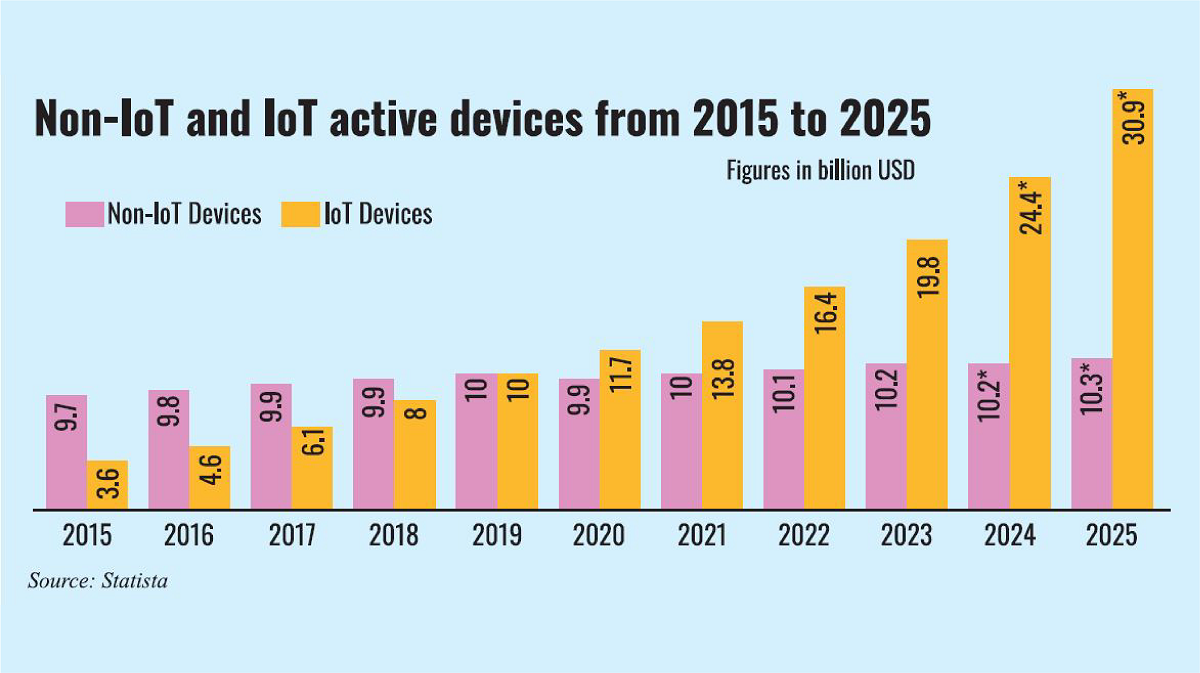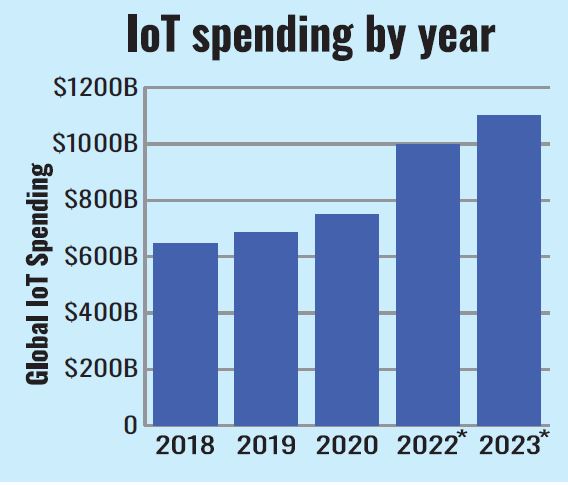Bangladesh’s path to IoT and firmware-based industrial prosperity
December 03, 2023

While IOT and Software are buzzwords that most people are familiar with by now, few people in Bangladesh know about Firmware or Embedded systems that make up the IOT industry.
In recent years, Bangladesh has started to penetrate the global software industry. With a CAGR (Compound Annual Growth Rate) of 1.83% in the ICT market, the currently estimated 2 billion dollar software industry in Bangladesh is guaranteed to grow in the following years. However, there is a lot of room for improvement since the global software industry size is currently estimated at 652.1 Billion USD, and with a CAGR of 11.5%, it will more than double by 2030.

Despite the progress made in the software industry, there is almost no progress made in the embedded systems or IOT industry, which has the potential to be the biggest industry in the future.
Firmware is, in the simplest terms, a piece of software dedicated to executing specific tasks by hardware. While the software is intended for human-computer interaction, firmware is for communicating with the hardware, so the firmware is generally developed with low-level programming languages with lower abstraction levels.
Embedded systems and IOT are examples of technologies containing firmware. Embedded systems vary significantly in complexity. They can range from simple devices with a single microcontroller chip to complex systems with multiple units, peripherals, and networks. Digital Cameras, MP3 Players, and Smart home appliances are all examples of embedded systems. IoT refers to the ‘Internet of Things,’ a network of smart network-based or physical devices and appliances through internet connectivity. Firmware is used in IoT devices or embedded systems to use data from sensors and other electrical components and execute specific commands on hardware devices/modules.
The world is gradually shifting towards smarter solutions and devices as technology thrives. Whether it is healthcare, a smart home, a driverless automatic car, or a smart air conditioner, all depend on the firmware to execute hardware-specific tasks and use sensor data to offer better experiences. Even computers and mobile phones employ some firmware forms to allow the user end software and operating systems to perform specific hardware-based tasks. Almost any real-life machines and devices can offer better services by making them smarter, which depends on firmware.

The total number of IoT devices in the world right now is more than 15 billion, which has already exceeded the number of overall people on Earth. The number is estimated to grow to 25 billion in the next five years. The growth rate could be even higher considering how IoT and smart devices can significantly improve efficiency in agriculture, healthcare, home appliances, banking, military applications, manufacturing, energy production, etc. That is why the IoT industry alone has surpassed 600 billion USD market size before 2023 and is estimated to cross 3 trillion dollars by 2030 at an astonishing CAGR of 26.1%.
Despite the promising future, Bangladesh has yet to make significant ground in this industry. The National Internet of Things Strategy adopted in 2020 by the Bangladesh government set goals like increasing the IoT market size to 1 billion USD by 2023 and creating 10,000 skilled workforce for domestic and international markets. That goal is yet to be materialized as IoT-based startups are still low, and major manufacturing and other companies are not yet focusing on this industry. Bangladesh plans to earn 5 billion USD in IT exports by 2025 and create 100,000 jobs inside the country in the digital device manufacturing industry. Digital/smart device manufacturing development inside the country will surely need more firmware, IoT engineers, and experts to design and develop products intended for mass production.
Some popular tech companies in Bangladesh develop firmware as a component for their products, but that number is extremely low compared to other countries. For example, the IT industry in India already accounts for 7.4% of its GDP in 2022, and the IoT market size is estimated to grow towards 60 billion USD by 2028.
IoT devices and embedded systems all require chips like microprocessors or microcontrollers. Since Bangladesh has not made much ground in the semiconductor industry, developing the chips inside the country soon seems impossible. Instead, Bangladesh can penetrate the firmware and embedded systems development industry, which uses imported microprocessors and chips, and develop firmware to design and produce IoT devices and embedded systems inside the country.
Bangladesh still relies on remittance from nationals working overseas in mostly service-based and garment industries to keep the economy stable. With the development of increasingly smart home devices and appliances, the remittance from service-based industries will surely take a hit as developed countries shift towards smart devices to provide services instead of manual labor. The garments industry is also at risk as automation in the garments industry could very well mean that Europe and the USA will soon produce all garments inside their countries instead of depending on low assembly costs from third-world countries. That is precisely why Bangladesh has to focus on more promising industries for the sake of the future.
As of now, the biggest percentage of nationals working in foreign countries have low-level skills, which means they can only participate in low-level service jobs with low wages. But if the National Internet of Things Strategy were to succeed and Bangladesh could produce more skilled workers for the IoT field, that could ensure a far better remittance yield from nationals working overseas. The same argument stands for university graduates, too. With the unemployment rate among university graduates rising every year, a more industry-oriented focus in universities to produce firmware engineers or developing more Technical Institutes for skilled workers could mean better employment opportunities both inside and outside the country, which will also help the national economy. This will also help the development of IoT-based startups to export more and more IoT and firmware-based products.
Bangladesh spends the most on importing IoT-based products and technological devices. Whether it is high-end medical equipment, sensors, simple digital devices, smart home appliances, embedded systems-based devices for connectivity, or other purposes, Bangladesh heavily relies on imports. Development of IoT and firmware-based industries could not only mean a rise in exports, it could also mean a lot less of the national reserve spent on imports of devices that could easily be manufactured inside the country. If Bangladesh produces more firmware engineers and experts, that could also heavily increase the potential market size for Bangladesh and the IoT device market. Currently, most industries inside the country focus on just the assembly process without manufacturing the actual components; that could change if Bangladesh brings the manufacturing process for IoT device components.
Whether Bangladesh can make it in the promising firmware and IoT market in the future depends on the government, universities, and prominent companies investing in Research and Development in this field. With the right circumstances, Bangladesh could become a leading IoT product and firmware exporter globally.
azaher.anik.2332.csedu@gmail.com
Most Read
You May Also Like